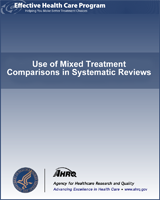Background
Clinicians and decisionmakers often have to select from multiple available interventions when determining the optimal treatment for disease. Ideally, high-quality randomized controlled trials (RCTs) that estimate the effectiveness of all possible interventions directly against one another would be available to guide decisionmaking.1,2 However, interventions are commonly compared with placebo or non-active control in RCTs rather than another active intervention and when direct comparative trials exist they are between two of a larger group of possible treatments. As such decisionmakers are faced with a lack of adequate direct comparative data to make their judgments.
In the absence of direct comparative data, indirect comparisons may provide valuable information. For example, if two different interventions have been evaluated against a common comparator, the relative effects of the two interventions compared with each other can be estimated indirectly.1,2 Even in the presence of direct comparative data, indirect comparisons may add value to the interpretation of comparative effectiveness, as usually more than two treatments for a given disease are considered in clinical practice (even if all treatments are not directly compared).
According to the Conducting Quantitative Synthesis When Comparing Medical Interventions chapter of the Evidence-based Practice Center (EPC) methods guide, investigators may choose to implement an indirect or mixed treatment comparison (MTC) in order to make statistical comparisons between interventions.3 Several methodologies exist to indirectly compare interventions, as do modes to implement such methodologies.1,4-7 These include anchored indirect comparisons as described by Bucher et al.,4 Frequentist MTC5 and Bayesian MTC.6,7 In the simplest form, interventions that are evaluated against a common comparator in separate trials can be compared to each other indirectly using an anchored indirect treatment comparison approach.4 This and related approaches have been previously addressed in a heath technology assessment report by Glenny et al. and consequently are not the focus of this report.8 As a generalization of indirect comparisons, when more than two treatments are being compared indirectly, and at least one pair of treatments is being compared both directly and indirectly (a closed loop is present), both direct and indirect types of data can be used to estimate effects in a network meta-analysis using a Bayesian or Frequentist framework.1,2,4-7 Although these latter methodologies for synthesizing networks of studies with at least one closed loop are frequently employed, best practices for their use are unclear.1,2,9
Objectives
This report is divided into three parts, each with its own objective.
- Part one: Summarize publicly available guidance discussing when and how to conduct a MTC as well as how to interpret and report the results of such analysis. We will highlight guidance on methods to synthesize MTCs. However, we will also summarize guidance applicable to network meta-analysis in general when such guidance also applies to MTC.
- Part two: Identify either Bayesian or Frequentist MTCs that were published since 2006, and summarize their characteristics.
- Part three: Gather insight from investigators who have conducted either Bayesian or Frequentist MTCs, as identified in part two of this project. More specifically, investigators will be queried about how elements of such methodology should be chosen and reported.
Project-Specific Terminology
Throughout this report we will use the following specific definitions:
- Closed loop: Each comparison has both direct evidence and indirect evidence. For example, consider AB trials, AC trials, and BC trials. The BC comparison has direct evidence from the BC trials and indirect evidence from the AB and AC trials (and similarly for the AB comparison and the AC comparison)
- Mixed treatment comparison (MTC): A statistical approach used to analyze a network of evidence with more than two interventions which are being compared indirectly, and at least one pair of interventions compared both directly and indirectly9
- Bayesian framework: An approach that can be used to conduct MTCs (as well as simpler indirect treatment comparisons) involving a formal combination of a prior probability distribution, which reflects a prior belief of the possible values of the model parameter of interest, with a likelihood distribution of these parameters based on the observed data, to obtain a corresponding posterior probability distribution.9
- Introduction - Use of Mixed Treatment Comparisons in Systematic ReviewsIntroduction - Use of Mixed Treatment Comparisons in Systematic Reviews
Your browsing activity is empty.
Activity recording is turned off.
See more...
